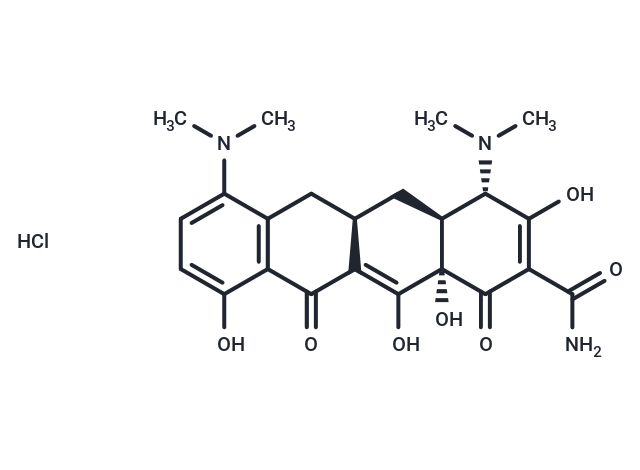Shopping Cart
Remove All Your shopping cart is currently empty
Your shopping cart is currently empty
Minocycline hydrochloride (Minocycline HCl) is a tetracycline antibiotic with excellent absorption and tissue penetration that is used for several bacterial infections as well as treatment of acne. Minocycline hydrochloride can cause both an acute hepatitis-like syndrome occurring within 1 to 3 months of starting therapy or a more insidious chronic hepatitis with autoimmune features typically after long-term treatment.

| Pack Size | Price | USA Warehouse | Global Warehouse | Quantity |
|---|---|---|---|---|
| 25 mg | $38 | In Stock | In Stock | |
| 50 mg | $50 | In Stock | In Stock | |
| 100 mg | $62 | In Stock | In Stock | |
| 200 mg | $92 | In Stock | In Stock | |
| 1 mL x 10 mM (in DMSO) | $50 | In Stock | In Stock |
| Description | Minocycline hydrochloride (Minocycline HCl) is a tetracycline antibiotic with excellent absorption and tissue penetration that is used for several bacterial infections as well as treatment of acne. Minocycline hydrochloride can cause both an acute hepatitis-like syndrome occurring within 1 to 3 months of starting therapy or a more insidious chronic hepatitis with autoimmune features typically after long-term treatment. |
| Targets&IC50 | NO production (LPS-induced RAW246.7 macrophages):34.81 μM, Ih amplitude:41 μM, NO production (LPS-induced BV2 cells):9.07 ± 0.86 μM, MCF-7 cells viability:36.10 µM |
| In vitro | Minocycline exhibits significant neuroprotective effects in models of cerebral ischemia, traumatic brain injury, Huntington's disease, and Parkinson's disease. Its neuroprotective properties may involve the inhibition of 5-lipoxygenase (an inflammatory enzyme associated with brain aging). Additionally, Minocycline's activity is linked to the inhibition of protein synthesis. |
| In vivo | Minocycline inhibits the release of cytochrome c mediated by the permeability transition in mitochondria. This inhibition by minocycline on cytochrome c release has been demonstrated in vivo, in cells, and isolated mitochondria. Additionally, minocycline suppresses the activity of inducible caspase-1 and caspase-3, inducible nitric oxide synthase (iNOS), and p38 mitogen-activated protein kinase (MAPK). Following experimental focal ischemia, minocycline reduces the upregulation of caspase-1 and iNOS, thereby decreasing infarct size. |
| Synonyms | Minocycline HCl |
| Molecular Weight | 493.94 |
| Formula | C23H28ClN3O7 |
| Cas No. | 13614-98-7 |
| Smiles | Cl.[C@@H]12[C@](C(=C3[C@H](C2)Cc2c(C3=O)c(ccc2N(C)C)O)O)(C(=O)C(=C([C@H]1N(C)C)O)C(=O)N)O |
| Relative Density. | no data available |
| Color | Yellow |
| Appearance | Solid |
| Storage | Powder: -20°C for 3 years | In solvent: -80°C for 1 year | Shipping with blue ice/Shipping at ambient temperature. | ||||||||||||||||||||||||||||||||||||||||
| Solubility Information | H2O: 5 mg/mL (10.12 mM), Sonication is recommended. DMSO: 257.5 mg/mL (521.32 mM), Sonication is recommended. | ||||||||||||||||||||||||||||||||||||||||
| In Vivo Formulation | Saline: < 1 mg/mL (insoluble) Please add the solvents sequentially, clarifying the solution as much as possible before adding the next one. Dissolve by heating and/or sonication if necessary. Working solution is recommended to be prepared and used immediately. The formulation provided above is for reference purposes only. In vivo formulations may vary and should be modified based on specific experimental conditions. | ||||||||||||||||||||||||||||||||||||||||
Solution Preparation Table | |||||||||||||||||||||||||||||||||||||||||
H2O/DMSO
DMSO
| |||||||||||||||||||||||||||||||||||||||||
| Size | Quantity | Unit Price | Amount | Operation |
|---|

Copyright © 2015-2026 TargetMol Chemicals Inc. All Rights Reserved.